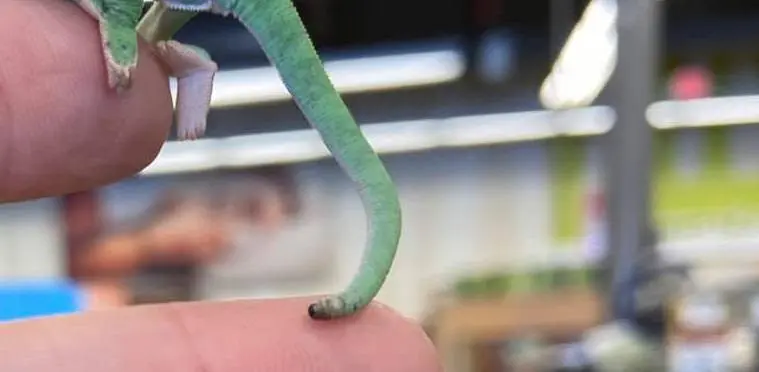Tail rot is a serious condition for chameleons. It results in the tail rotting away. It becomes infected, turns black, and basically rots. If not treated, the tail can fall off and the infection can spread up the body, negatively impacting the internal organs of your reptile pet.
Knowing what to look for, how to prevent it, and when to seek veterinary treatment can ensure the best outcome for your chameleon.
Symptoms of Tail Rot in Chameleons
Tail Black
One of the first symptoms you may notice is your chameleon’s tail starts turning black.
If your chameleon is still curling its tail in and out and moving normally, then the blackness could be just a bruise. You will want to keep a close eye on your pet to ensure it doesn’t get any worse and does heal on its own.
Related –Why does my chameleon have black spots?

Swelling
Most chameleon owners notice swelling of the tail. As the tail rot progresses, you will see discoloration at the swollen area. The tissue will become fragile and the tail may need to be surgically removed.
Note that the infection can move up the body and can take several weeks before the infection completely runs its course.
Causes
There are numerous reasons why your chameleon has developed tail rot, these include:
- Bacterial infection
- Humidity too high and your chameleon has been living in a damp environment for too long
- Not shedding properly and the skin tightens around the tail, reducing the flow of blood to the tail.
- Malnutrition
- Trauma
Treatment
Treatment varies on the severity of the tail rot. In most cases when the tissue dies, the tail will fall off on its own.
You need to worry if the discoloration and swelling moves up the tail, which means the infection is spreading and will require antibiotic treatment from your reptile vet.
Treatment may include one or more of the following:
- Careful monitoring, examination, diagnosis, and treatments
- Surgical removal of the tail
- Antibiotics
- Cream to keep tail soft and encourage it to fall off on its own
- Veterinary assistance in removing retained shed
- Review habitat regarding diet, heat, humidity, and lighting
The prognosis for your chameleon if the tail rot hasn’t spread, is good and it can continue living a healthy and happy life once the tail rot has been treated and the dead section of the tail has fallen off or been removed.
In many cases, tail rot needs to be treated with surgery, which includes anesthetizing the chameleon. A sterile prep is readied and the cut is made in front of the discoloration on the tail. All unhealthy tissues are removed.
Some vets choose to suture the tail closed to reduce the risk of debris getting into the wound during the healing process.
Prevention
Prevention is always better than cure and if you’re worried your chameleon may get tail rot, then there are a few things you can do to reduce the risk.
Humidity
You need to ensure that the humidity within the chameleon enclosure is between 65% and 80%. If you allow it to go higher than this, your chameleon will be living in a damp environment, which is not good for their overall health.
Mist up to several times a day to keep humidity levels at optimum to ensure your pet continues to remain comfortable and healthy.
Diet
Ensure you provide your chameleon pet with a healthy and well-balanced diet. Some chameleons are insectivores only, others are omnivores.
For insectivores, provide recently gut loaded crickets, roaches, wax worms, and mealworms.
Omnivorous chameleons can enjoy the same insects, combined with dark, leafy greens including pothos, ficus leaves, and collard greens.
Accessories
Due to the fact your chameleon is going to spend most of its time climbing and hiding on branches and vines, you want to reduce the risk of trauma to the tail by ensuring that all branches, vines, and accessories are firmly in place to reduce the risk of your chameleon falling and having something land and damage its tail.
Related –Why is a chameleon hanging upside down?
Habitat Hygiene
Keeping the habitat clean is a very important part to reduce the risk of any infection, including tail rot.
Carry out daily cleaning to remove debris, left over insects, and feces.
Weekly cleaning should include removing and disinfecting any accessories and branches.
Every six months clean the entire enclosure from top to bottom using a high-quality reptile disinfectant.